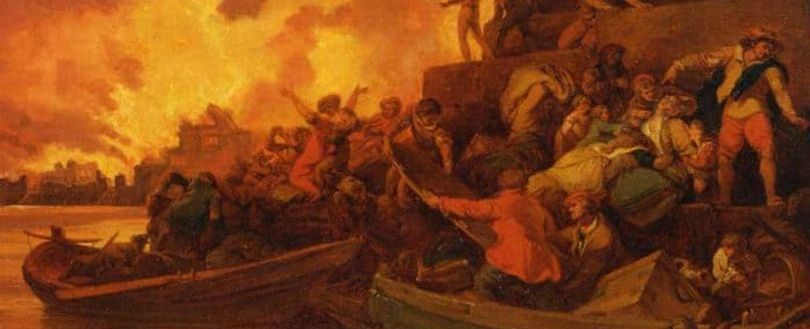- Homepage
- News
- Blogs & Articles
- On this day, historic disasters: The Great Fire of London 1212

On this day, historic disasters: The Great Fire of London 1212
Like it? Share it!
10 July 2024 by FIA Team, FIA Team
The Great Fire of Southwark erupted on 10th July 1212, in what was a vibrant area of the city just south of the River Thames. The exact cause of the fire remains unknown, but contemporary chroniclers suggest it may have started in a bakery or in the home of a wealthy citizen. At the time, London was a city of closely packed, timber-framed buildings with thatched roofs, which created an environment highly susceptible to fire. The hot, dry summer conditions likely exacerbated the rapid spread of the flames.
The fire swiftly moved northwards, reaching London Bridge—a vital connection between Southwark and the City of London. The bridge, lined with shops and residences, facilitated the fire's spread across the Thames. Medieval firefighting techniques were rudimentary, relying primarily on bucket brigades where citizens formed human chains to pass buckets of water from the river to the fire. These efforts were largely ineffective against the intense heat and speed of the fire’s spread.
The fire's rapid advance was facilitated by the city's narrow, winding streets and the close proximity of wooden buildings. Efforts to control the blaze were further hampered by the lack of an organised firefighting service. Londoners relied on ad hoc community efforts, which proved insufficient. The fire consumed homes, churches, and businesses, causing significant destruction. Contemporary accounts, such as those by the monk Matthew Paris, suggest that thousands may have died, with many many trapped on London Bridge caught between flames advancing from both sides of the river. Whilst many of the fatalities were attributed to the fire itself, others were believed to have been caused by crush injuries in the mass panic to escape, whilst some of those who jumped into the Thames were believed to have drowned. Other documented accounts from historians such as the one documented in 1603 by John Stow suggested that the number of fatailities may have exceeded 3000, though many modern historians agree this may have been exaggerated as the entire population of London at the time was no more than 50,000.
In the aftermath, London faced the immense task of reconstruction. The fire had devastated a large portion of the city, leaving thousands homeless and leading to a significant economic impact. Rebuilding efforts saw some improvements in building regulations. Stone began to replace timber in some structures, but financial and logistical constraints meant that many new buildings were still constructed from wood.
The investigation into the fire’s cause and spread highlighted the city's vulnerabilities but did not lead to immediate widespread reforms. The disaster enhanced the need for better urban planning, more fire-resistant building materials, and organised firefighting efforts. However, comprehensive fire prevention measures were not implemented until much later after the more infamous blaze of 1666.
For today's fire industry professionals, the Great Fire of London in 1212 underscores several key lessons. The importance of using fire-resistant building materials, having an organised firefighting service, and urban planning that mitigates fire risks cannot be overstated. While technology and methods have significantly advanced since the 13th century, the fundamental principles of fire safety remain relevant.
Examining historical fires like the Great Fire of 1212 helps contextualise modern practices and reinforces the ongoing need for vigilance, innovation, and education in fire prevention and management. By learning from past disasters, we can better protect our communities and infrastructure from future threats.
This historical perspective reminds us that while we have made significant strides in fire safety, the principles of fire prevention, rapid response, and effective urban planning remain timeless. Understanding and applying these lessons are crucial for building a safer future.
-

FIA Team
FIA Team
Related posts
-
Fireside Chat with the Portables Product Manager at Chubb Fire and Security, Guy Middleton
24 October 2024
By Charlotte Brill, Content Marketing Executive
-
A Fireside chat with Managing Director and Technical Lead of Firetronik, John Haynes
19 May 2024
By Charlotte Brill, Content Marketing Executive
Related news
-
March 2025 Data Release on Building Safety Remediation
22 April 2025
-
The FIA Supports PSTN Transition Efforts Led by BSIA
09 January 2025
-
FIA Members Shine at the Security and Fire Excellence Awards 2024
06 December 2024
